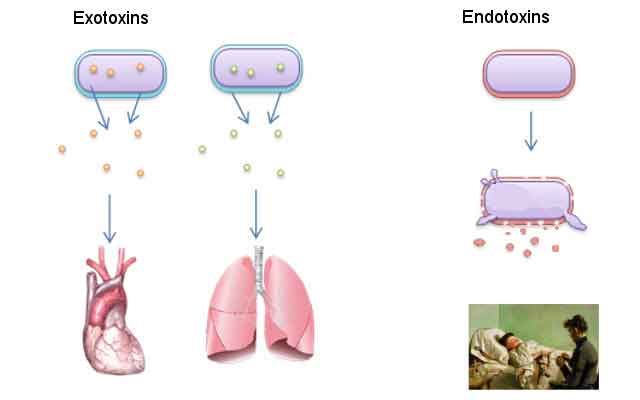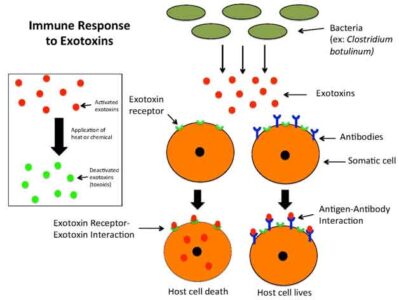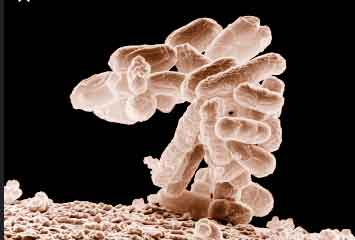Micro-organisms such as bacteria, fungi produce toxic substances that boost up the infection and diseases through damaging the host tissues and by troubling the immune system. The most potent and known natural bacterial toxin is Botulinum neurotoxin which has essential uses in research and medical science. At present, toxins are used as tools in cellular biology and neurobiology to develop anticancer drugs and other medicines. Toxins from bacteria act as virulence factors that influence the functions of the host cell to help microbial infections. Toxins produced from bacteria can be either endotoxins or exotoxins. These toxins play a pivotal role in leading various diseases and infections.
Endotoxins
Endotoxins are lipopolysaccharides toxic substances which are part of the outer membrane of the gram-negative bacteria. Generally, it is released when the bacterium is killed, or cell lyses by the immune system due to action of phagocytic digestion or specific antibiotic actions. It is found in the body of the following bacteria species:
- Escherichia coli
- Shigella
- Salmonella typhi
- Pseudomonas
- Haemophilus influenza
- Neisseria
- Vibrio cholerae and
- Bordetella pertussis




Image Showing Some Bacteria Species Which Secrete Toxic Substance
Endotoxins have different physical and chemical characteristics which consist of 2 components, namely hetero-polysaccharide and lipid A. Endotoxins are stable heat proteins that make the body wall of gram-negative bacteria. They are one kind of pyrogens that act as fever-causing agents. Fatty acids and disaccharide phosphates are the main components of the endotoxins. It also bears core polysaccharides and O antigen.
During the development period of bacteria, they release small quantities of endotoxins which help to enhance natural immunity. The host body shows a response to endotoxins and makes severe inflammation. Generally, the inflammation is beneficial to the body of the host, but it can lead to sepsis if the inflammation is severe enough.

Some Clinical Features and Significance of Endotoxins
- It is characterized as lipopolysaccharides (LPS).
- They are present in the cell wall of bacteria.
- Endotoxins are released by the gram-negative bacteria during cell lysis.
- They are heat-stable proteins.
- They can remain active up to 100 °C temperatures.
- Endotoxins are lethal to the host body when it is released large quantities.
- They show a non-specific effect on the body of the host.
- Generally, antibodies cannot neutralize endotoxins.
- There is no specific receptor for the entrance of endotoxins to the host body.
- They show a poor antigenic nature.
- The host body is susceptible to fever when the body gets in touch with the endotoxins.
- Releasing of endotoxins mainly depend on the genes of the bacterial chromosome.
Exotoxins
Exotoxins are one of the most contagious toxic substances, which are secreted by both gram-positive (+) and gram-negative (–) bacteria into the surrounding at the exponential phase of the bacterial cell. They have proteins or polypeptides in nature and show enzymatic or direct action of the host cell. They can cause extreme injury to the host body by damaging the cells or by obstructing the metabolism of cells.
Various bacteria release exotoxins which cause diseases to the host. Many types of exotoxins are identified. Among them, the most common ones are:
- Botulinum Toxin
- Enterotoxin
- Cholera Toxin
- Diphtheria Toxin
- Tetanospasmin
Some important health disorders by exotoxins include Tetanus, Cholera, and Diphtheria. Among them, the notable bacteria Clostridium tetani produce tetanus toxins, Vibrio cholerae produces cholera toxins while Cornybacterium diphtheria produces diphtheria toxin. Exotoxins are of three categories, such as Enterotoxins, neurotoxins, and cytotoxins. In this case, Enterotoxemic action is found in the gastrointestinal tract; neurotoxins show their functions on neurons while cytotoxins prohibit the function of the host cell.

Some Clinical Features and Significance of Exotoxins
- They are characterized as protein in nature.
- During releasing exotoxins, the bacterial cell does not need to undergo lysis.
- Exotoxins are heat sensitive, and if you expose them to heat with a temperature beyond 600 C, it becomes destroyed.
- They have specific effects on the host body, and they enter into the host cell by using specific receptors.
- They are extremely lethal to host with a small amount.
- It has a high antigenic nature, and you can neutralize it by using antibiotics.
- Sometimes, they cause fever to host, and there are available vaccines for neutralizing the action of exotoxins in the market.
- They are secreted into the surrounding by both gram-positive (+) and gram-negative ( –) bacteria.
Differences between Endotoxins and Exotoxins
The following table shows the differences between Endotoxins and Exotoxins
| Endotoxins | Key Features | Exotoxins |
| It is characterized as Lipopolysaccharides (LPS). | Chemical Nature | It is protein in nature. |
| It is produced by gram-negative bacteria. | Sources | It is produced by both gram-positive and gram-negative bacteria. |
| It releases enzymes like Catalase, IgA / IgG proteases, Fibrolysin, etc. | Enzymes | It releases enzymes like Hyaluronidase, certain protease, Collagenase, Nuclease, Neuraminidase, Phospholipase A, etc. |
| It is found inside the cell membrane of gram-negative bacteria. It is released after lysis of the cell wall. | Location | t is released into the surrounding by both gram-negative and gram-positive bacteria. |
| They are heat tolerant and can stable up to 2500 C temperatures for one hour. | Heat sensitivity | They are heat liable and can get destroyed at a temperature between 60 and 800 C. |
| It does not produce antitoxins and shows weak immunogenicity. | Immunogenicity | They show high immunogenicity and secrete antitoxins to neutralize the toxin by stimulating the immune system. |
| The molecular weight of endotoxin is 50-1000 KDa. | Molecular Weight | The molecular weight of exotoxin is 10 KDa. |
| It shows poor antigenicity. | Antigenicity | It shows high antigenicity. |
| Its effect is non-specific. | Specificity | It is specific to particular bacterial strain. |
| It does not show any enzymatic activity. | Enzyme activity | It always shows enzymatic nature during activities. |
| Often it can cause fever in the host. | Pyrogenic / Fever | It does not cause fever or occasionally cause fever in the host. |
| It cannot be denatured on boiling. | Denature | It gets denatured on boiling. |
| The genes are located in the bacterial chromosome which is responsible for producing endotoxins. | Genes | The genes are located in the plasmid of the bacteriophage genome, which stimulates to produce exotoxins. |
| It is detected by using limulus lysate assay test. | Detection of toxins | It is detected by using various methods like ELISA-based method, Precipitation, Neutralization, etc. |
| For entering into host body, generally, it has no specific receptors. | Receptors | For entering into the host body, generally, exotoxins use specific receptors. |
| It becomes lethal only with large amount. | Deadly behavior | It becomes lethal only with very minute quantities. |
| It does not shows any affinity towards specific tissues of the host. | Affinities | It shows an affinity towards specific tissues of the host. |
| It can cause various health disorders such as urinary tract infections, Coronary artery disease, Neonatal Necrotising Enterocolitis, typhoid fever, meningococcal meningitis, Cystic Fibrosis, Crohn’s Disease and Ulcerative Colitis, Meningococcaemia, sepsis, haemorrhagic shock, etc. | Diseases | It can cause the following health disorders: Diphtheria, Gas gangrene, Antibiotic-associated diarrhea, Scalded skin syndrome, Scarlet fever, Botulism, tetanus, etc. |
| Generally, antibodies cannot neutralize the endotoxins. | Neutralization | It can be neutralized using antibodies. |
| There are no available vaccines against endotoxins. | Vaccination | There are available vaccines against exotoxins. |
| It does not convert to toxoids. | Conversion | It converts to toxoids. |
| Escherichia coli, Salmonella typhi, Shigella, Psedomonas, etc. | Examples | Bacillus anthracis, Bacillus cereus, Staphylococcus aureus, Streptococcus pyogenes, Vibrio cholerae, etc. |
Concluding Remarks
There are numerous bacterial toxins which hamper the host cells in different manners. They inhibit protein synthesis, destroy the host cells, and cause various health disorders. Toxins delivered from microscopic organisms can be either endotoxins or exotoxins. Endotoxins upgrade or restrain the pathogenicity of disease. Exotoxins are protein in nature which can also damage the host cell membranes and interfere with the host cell functions. Exotoxins become deadly with limited quantity while endotoxins are less deadly than exotoxins, yet they can make fever the host.

